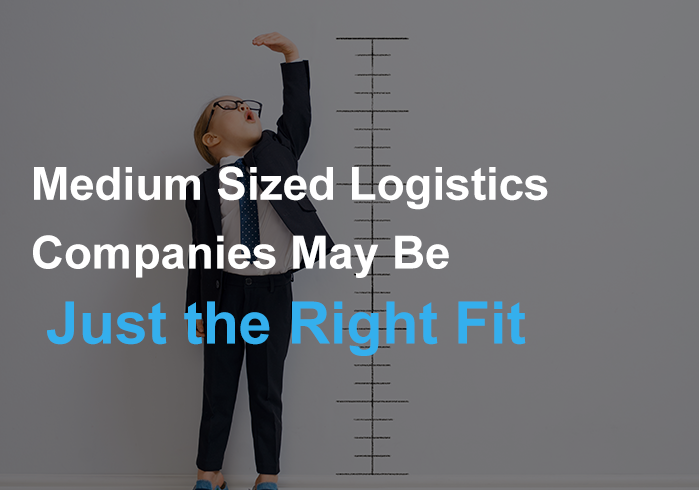
At a time when industries are getting to the grips of a post-Covid era of high demand and limited capacity, it is important to think about logistics. This article urges companies to look again at medium-sized logistics companies as a possible alternative. Perhaps, it is time to acknowledge that bigger logistics outfits are not always the most appropriate for your business needs.
Choosing a third-party logistics provider
One of the key business decisions for any company that is involved in importation and exportation at any level is the choice of a logistics partner. Typically, third-party logistics (3PL) providers have been the staple for the shipping industry. However, the larger ones have become so distracted by their range of interests and responsibilities that they are beginning to neglect some of the smaller orders.
The advantage of going with a smaller 3PL provider is that they may offer a more personalized service that is uniquely suited to your needs. Although smaller companies do not always provide the high volumes that would sustain a larger 3PL provider, they too need logistics support. The medium-sized 3PLs are filling this gap. Several advantages can emerge from this arrangement:
Smaller logistics companies have a regional presence
The smaller orders are diversely distributed in regions that do not always get the full attention of larger 3PLs. However, medium-sized 3PLs specialize in hard-to-reach places where there is demand but the demand is not large enough to attract a more substantial 3PL. This becomes particularly important when trying to minimize transit times and the resultant negative effect they have on your bottom line.
A smaller 3PL that is close to you will reduce transit times significantly. This makes sense, bearing in mind the disruption to the supply chain that has emanated from the Covid-19 pandemic. Having a centralized distribution point can be a significant advantage, not only because of its convenience but also because of the reduction in operational costs.
In an ideal situation, regional companies will reach all the areas that need them. This can be by way of distribution companies or subsidiaries. A true regional company may have multiple facilities that reach as many places as possible. Additionally, they will have built a substantial network of business relationships that their customers can benefit from. Hence, it becomes much easier to find the right carriers and suppliers.
These regional distribution centers are developing innovations that make life considerably easy for their clients. For example, they may combine loads with other clients who have small orders. This can bring in economies of scale and ensure that smaller clients are getting a bite of the cake. Another specialization is the development of unique capacities such as special equipment that can deal with the goods of a certain industry or focus on one product. So, if you are moving niche items, these medium-sized 3PLs may be the way to go.
You are more likely to get personalized service with a medium-sized provider
Larger 3PLs do not have the time for personalization. It is the medium-sized alternatives that can give you this level of attention. The key starting point is to ensure that the provider uniquely meets your specific needs.
There are many benefits associated with personalization, including the ability to quickly engage with the right person if you have a question or problem. The medium-sized 3PLs will have an intimate knowledge of your company and its needs. The service that they eventually provide will be uniquely suited to you. They will ensure that your perspectives are never overlooked in their planning, something that would be practically impossible with the largest 3PL companies.
Because you are one of their prized clients, as opposed to being one of many clients lost in the crowd, the medium-sized 3PLs will go that extra mile in providing you with the answers you need. For example, they can give you tips on efficiency and savings. Your account is set up in a simple and accessible way, before being monitored regularly by a dedicated staff team. In this way, you are getting the best advice on how to improve the efficiency of your supply chain.
Although these smaller 3PLs do not have the technical power of the largest industry players, they do provide high-quality order fulfillment services. They are also a lot more flexible since they are running a smaller list of clients. Larger 3PLs will set up certain rules and procedures which you must follow. By way of contrast, medium-sized 3PLs follow you throughout your journey of growth, development, and branding.
Medium-sized 3PLs are increasing their use of modern technologies
Although there was once a stereotype of smaller and medium-sized 3PLs that were reliant on old techniques, this is fast changing. Many of these medium-sized 3PLs have commissioned and deployed advanced technologies to improve the quality of service that they provide to their customers. They routinely offer advanced information systems because they recognize the competitive advantages they bring.
Having access to modern technology brings incalculable benefits. For example, many medium-sized 3PLs have broken away from the smallest 3PLs by switching to inventory management software (IMS). Consequently, it is possible to connect various components of the distribution process in a highly efficient manner. Hence, you get valuable insights into the processes and requirements of order fulfillment; inventory management; and ordering.
Additionally, these medium-sized 3PLs are looking to enhance the integration of their information systems. The effect is an increased level of transparency and accessibility. Clients know what is happening to their products at any moment. They are also part of the process of evaluating the effectiveness of new IT systems.
Smaller 3PLs have harnessed the power of automation. This has made their work faster and easier. Resources such as personnel and time can then be deployed towards implementing bespoke warehouse management systems (WMS). Such innovations are critical for managing repeatable tasks in a limited timeframe. Through the strategic use of key performance indicators (KPIs), medium-sized 3PLs offer important baselines for improved services.
There is experience in the medium-sized 3PL market
Having been at the heart of the shipping and logistics business for years, medium-sized 3PLs have built a lot of experience. Many of them started their journey as the smallest 3PLs and are gradually building their capacity and competency. They have grown and cultivated their clients which makes them reliable and well-established in the community.
One of the signs of their experience is the multi-channel capabilities that they deploy. They also operate in both the Business-to-Business (B2B) and Business-to-Consumer (B2C) markets. This adds important flexibility for customers. Their interactions with many distributors and manufacturers make them an invaluable resource. Hence, you may find that they have significant expertise in transportation options, storage, load sizes, containers, products, and delivery schedules.
More importantly, medium-sized 3PLs provide value for money as a matter of necessity. They are conditioned to remain competitive in a market that is dominated by the largest and smallest players on each end. Being in the middle calls for advanced business acumen which translates into better operational efficiency. For example, they can offer attractive incentives such as reverse logistics, assembly, customer care, promotions, and sampling.
Wrapping up
As you make the important decision to go with a specific 3PL partner, do not neglect the possibilities of medium-sized options. The biggest firms are not always the best. Medium-sized 3PLs offer competency, experience, flexibility, and personalization.



